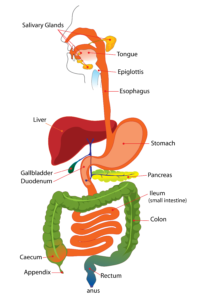64 From Mouth to Molecule: Digestion
While plants can produce their own energy using the process of photosynthesis, animals (and other organisms that can’t do photosynthesis) must eat to get energy from food molecules. Just like energy can be stored in the chemical bond between the second and third phosphate of an ATP molecule, energy can also be stored in the chemical bonds that make up food molecules. Most of the energy that we use comes from molecules of glucose, a simple sugar.
Food energy is chemical energy that animals (including humans) derive from their food through the process of cellular respiration. Cellular respiration involves either joining oxygen from air with the molecules of food (aerobic respiration) or reorganizing the atoms within the molecules in the absence of oxygen (anaerobic respiration).
Humans and other animals need a minimum intake of food energy to sustain their metabolism and to drive their muscles. Foods are composed chiefly of carbohydrates, fats, proteins, water, vitamins, and minerals. Carbohydrates, fats, proteins, and water represent virtually all the weight of food, with vitamins and minerals making up only a small percentage of the weight. In fact, carbohydrates, fats, and proteins comprise ninety percent of the dry weight of foods. Organisms derive food energy mainly from carbohydrates and fats present in the diet, and to a smaller extent proteins and other organic molecules. Some diet components that provide little or no food energy, such as water, minerals, vitamins, cholesterol, and fiber, may still be necessary to health and survival for other reasons. Water, minerals, vitamins, and cholesterol are not broken down; they are used by the body in the form in which they are taken in, so they cannot be used for energy. Fiber, a type of carbohydrate, cannot be completely digested by the human body so energy is not released from fiber when it is digested. Instead, it moves mostly intact through the digestive system.
After you put food into your mouth, you begin to break it down mechanically using your teeth. Enzymes in your saliva begin breaking the food molecules down as well. After you swallow your food, it is further broken down by additional enzymes in the stomach, followed by the small intestine. In the small intestine, the fully broken-down food is absorbed into the blood. The majority of the nutrients (about 95%) are absorbed in the small intestine. Water is reabsorbed from the remaining material in the colon. Then the residual waste is eliminated during defecation.

Once in the bloodstream, nutrients enter individual cells. Glucose is too large to diffuse through the cell membrane and is typically transported inside cells by proteins. After molecules enter a cell, the breakdown process to produce energy in the form of ATP can be completed.

